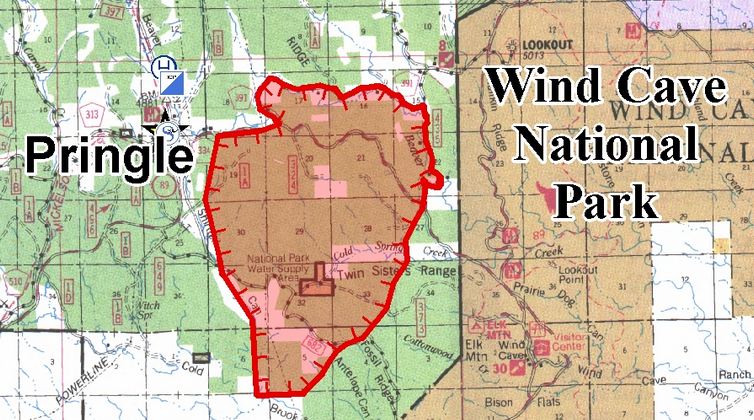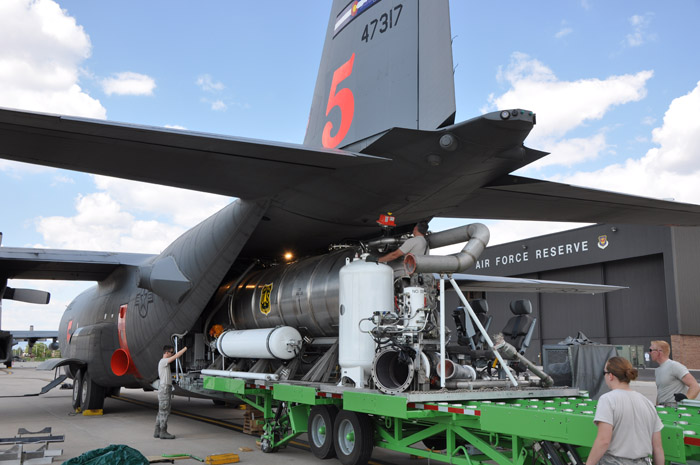(Originally posted at 10:10 a.m. MT, July 20, 2012)
Previous updates:
We will update this article throughout the day on Friday as new information becomes available.
================
UPDATE at 3:29 p.m., July 20, 2012:
The reason that Tanker 43, one of the two P2V air tankers assigned to the Myrtle fire, is not in operation, as we reported below, is that the 50-year old aircraft experienced a loss of power in one of its two main engines when taking off with a load of retardant at Rapid City Regional Airport. The Rapid City Journal reports that the tanker had to jettison its 18,000-pound load of retardant just after lifting off in order to safely remain airborne and return for a landing. Some of the retardant landed on two runways and a taxiway, closing the runways for about 40 minutes. Two inbound commercial flights orbited waiting for fire trucks and people with brooms to remove the retardant, but they eventually had to divert to Casper, Wyoming to refuel before they were finally allowed to land.
The retardant is very slippery and vehicles and aircraft should not attempt to drive or land on roads or runways covered with the chemical.
These very old air tankers that were discarded by the military 40 years ago have 18-cylinder radial piston engines with many, many moving parts. They frequently have a variety of problems that put the pilots in danger. Thankfully, the air crew survived this life-threatening emergency.
================
UPDATE at 1:23 p.m., July 20, 2012:
Only one large air tanker is working on the fire
Smoke fron the Myrtle fire is showing up on radar.
There is only one large air tanker working on the fire right now. There were two, both P2Vs, Tankers 07 and 43, but 43 is down with a mechanical issue. There was a rumor that Tanker 40, the jet-powered BAe-146 was dispatched from Missoula to the fire, but it got diverted to another fire in Montana while en route.
The DC-10 Very Large Air Tanker, which carries as much retardant as five P2V air tankers, 11,600 gallons, was laid off Monday by the U.S. Forest Service. There is currently a very significant shortage of air tankers. We only have 9, plus 3 that are borrowed temporarily from the state of Alaska. That number, 9, is down from the 53 we had in 2002. That is not enough to provide quick initial attack on new fires to keep them small, or enough to support large fires when the small ones become huge due in part, sometimes, to a lack of aggressive initial attack on new fires using overwhelming force. Air tankers do not put out fires, but under some conditions can slow them down enough to allow ground-based firefighters to contain them. The DC-10 is not the perfect tool for every fire, but it works very well on a large number of them. A P2V, BAe-146, or a Single Engine Air Tanker are not perfect for every fire either.
When the air tanker fleet has been reduced from 44 to 9, it’s an All-Hands-On-Deck situation. The DC-10 should not have been laid off from its Call When Needed Contract. There are also two other Very Large Air Tankers that are not being used at all; another DC-10 and a 747.

Hot Springs Fire Department was dispatched at 12:52 p.m. to assist the Minnekata Fire Department (west of Hot Springs) with voluntary evacuations “above Cottonwood”, the dispatcher said.
Only four of the seven military Modular Airborne FireFighting Systems C-130 air tankers are mobilized. If they were assigned to the Myrtle fire, they could not reload at the Rapid City Air Tanker base because the U.S. Forest Service is dragging its feet on approving the base for MAFFS air tankers, in spite of the fact that the base has been approved by the Air Force. MAFFS air tankers have been commonly used since the early 1970s, but the USFS has not gotten around to approving Rapid City for their use during the last 37 years.
Wildfires are very difficult to suppress even when competent leaders make excellent decisions and funding levels approved by Congress and the President are adequate. When the opposite is the case, it puts a tremendous burden on firefighters who are doing the best they can under very difficult conditions.
(End of update.)
================
UPDATE at 12:45 p.m. July 20, 2012:
The Myrtle Fire is very close to Wind Cave National Park, but as far as I know has not yet burned into the park, which is closed to the public, of course. On Thursday the staff gave pre-evacuation notices to all park residents. Today the power has been shut off and hand-held radio batteries are being charged off a generator that is running the gas pump. The high today will reach 99 degrees, the minimum relative humidity will be 21 percent, and the winds will be 10-14 mph with gusts to 18 out of the east and northeast. These conditions are conducive to significant fire spread to the west and southwest. HERE is a link to detailed weather forecast information for the specific area in which the fire is burning.
(End of update.)
====================


Here is some information provided by the Incident Management Team at 10:04 a.m on Friday:
The Myrtle Fire, reported yesterday, July 19, 2012 at 1:30pm approximately 1 mile east of Pringle, SD, has grown to 7500 acres and is 5 percent contained.
Residents north of Argyle road to highway 385 have been placed on evacuation notice. For more information on evacuations, please call Frank at (605) 673-8307. Argyle road remains open.
The American Red Cross has opened an emergency evacuation center [in Custer] at the Armory/Custer Middle School.
Wind Cave National Park has been closed until further notice.
Resources continue to arrive on scene and a type 1 [Incident Management] team [which is used for managing large, complex wildfires] will arrive today.
“Right now we are concerned about the area south of 385 and Pringle,” said Mike Carter, Emergency Coordinator for Custer County. “We have no concerns about Custer,” he said.
The public can go to Denver from Custer via Highway 385 and Highway 89 south to Denver.
People can get to Hot Springs from Custer- by going south on 385 and 89 to Minnekahta Junction.
Approximately 300 firefighter personnel are on scene.






